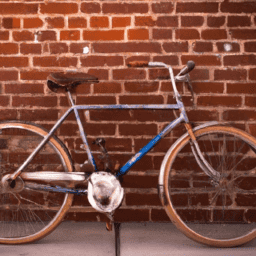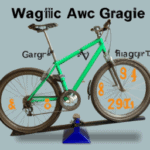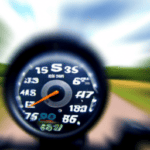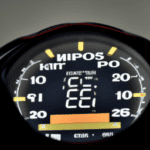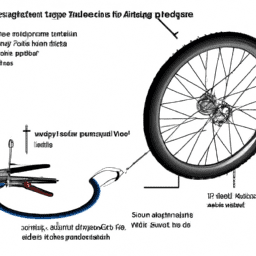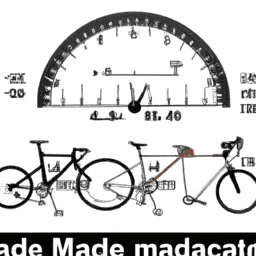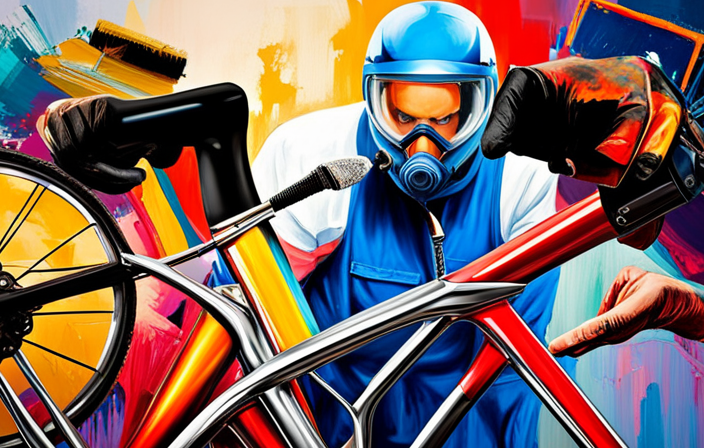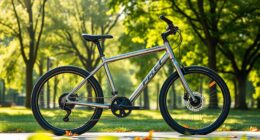As someone passionate about cycling, I’ve always found myself wondering about the typical speed of bicycles. The speed at which one can ride a bike depends on various elements, such as the rider’s expertise, the landscape, the conditions of the ride, and the characteristics and parts of the bicycle.
In this article, I will explore these factors and provide tips on how to improve your bike speed. The average speed of a bicycle can range from 10 mph to 25 mph, depending on the factors mentioned above.
It is important to note that the average speed is not the same as the maximum speed a bike can reach. Factors like wind resistance, gear ratios, and pedaling efficiency can affect the maximum speed a rider can achieve. However, the average speed provides a good benchmark for measuring a rider’s performance.
By understanding the factors that affect the average speed of a bike, riders can make informed decisions about their equipment and training to improve their performance.
Key Takeaways
- The average bike speed ranges from 10 mph to 25 mph, with professional cyclists reaching speeds over 60 mph during downhill races.
- Factors like wind resistance, gear ratios, and pedaling efficiency affect the maximum bike speed.
- Improving bike speed can be achieved through consistent training, proper nutrition, interval training, sprinting techniques, regular maintenance, upgrades, and professional bike fitting.
- Different bikes are designed for varying terrain and riding conditions, with mountain bikes having a wide range of gears for steep inclines and descents, and materials like carbon fiber and titanium being lighter and stiffer than aluminum, but more expensive.
Average Speeds of Bicycles
You might be surprised to know that on average, your trusty bicycle can reach speeds of up to 15 miles per hour! Of course, this speed can vary greatly depending on a few factors such as terrain, wind speed, and the type of bike being used.
However, for the average cyclist riding on flat ground with no wind resistance, this is a pretty standard pace. When it comes to pace comparison, it’s important to note that professional cyclists can reach record-breaking speeds of over 60 miles per hour during a downhill race.
But for the recreational cyclist, maintaining a steady pace of 15 miles per hour is a great way to get some exercise and enjoy the outdoors. Of course, the speed at which you ride also depends on your skill level, which we’ll discuss in the next section.
Rider Skill Level
Depending on your level of experience, you might be surprised at just how much control you have over your bike’s speed and maneuverability. As you become more skilled and comfortable with riding, you may find that you’re able to maintain higher average speeds for longer periods of time.
Improving your endurance through consistent training and proper nutrition can also play a significant role in increasing your average speed on a bike.
In addition to endurance, developing proper bike handling techniques can also contribute to faster average speeds. This includes learning how to shift gears efficiently, using proper braking techniques, and maintaining a stable riding position. By mastering these skills, you can ride with greater efficiency and control, which can translate to faster speeds.
As we move on to discussing terrain and riding conditions, it’s important to keep in mind that these skills will be put to the test in different ways depending on the specific conditions you encounter.
Terrain and Riding Conditions
Navigating through different types of terrain and varying riding conditions can be a thrilling and challenging experience for any cyclist. As a rider, I’ve come to realize that the terrain and riding conditions can significantly impact the speed at which a bicycle travels. Uphill challenges are notorious for slowing down even the most experienced riders, while downhill advantages can help one reach high speeds effortlessly.
When cycling uphill, the rider has to put in more effort to overcome the resistance of gravity. This results in a slower speed and a higher heart rate. On the other hand, downhill terrain provides a natural advantage for cyclists, allowing them to pick up speed and cover a greater distance in a shorter time. Riding on a flat surface is ideal for high-speed cycling, as there is no resistance from the terrain. Factors such as wind resistance, road surface, and temperature can also affect the speed and performance of a cyclist.
Transitioning into the subsequent section about ‘bike type and components,’ it is essential to understand how different bicycles are designed to handle varying terrain and riding conditions.
Bike Type and Components
Riding a mountain bike through rocky, uneven terrain requires a sturdier frame, wider tires with aggressive tread, and a suspension system to absorb shocks and vibrations. The type of bike and its components play a significant role in determining how fast it can go.
The frame material affects the weight and stiffness of the bike. Materials like carbon fiber and titanium are lighter and stiffer than aluminum, but they’re also more expensive.
Another factor that affects the speed of a bike is the gear ratios. Mountain bikes usually come with a wide range of gears to help riders tackle steep inclines and descents. Choosing the right gear can help you maintain a consistent speed and prevent fatigue.
However, having too many gears can also add weight to the bike and make it less efficient. Understanding your bike’s gear ratios and using them effectively can help you optimize your performance and improve your speed.
With these considerations in mind, let’s explore some tips for improving your speed on a mountain bike.
Tips for Improving Speed
When it comes to improving speed on a bicycle, there are a few key areas to focus on. First, consistent training and practice are essential to building endurance and increasing speed over time.
Secondly, ensuring a proper bike fit can greatly improve efficiency and reduce drag.
Finally, regular maintenance and upgrades, such as upgrading components or keeping tires properly inflated, can also contribute to faster speeds.
By focusing on these areas, I can work towards achieving my cycling goals and improving my overall performance.
Training and Practice
To become a faster cyclist, you gotta put in the work and pedal like a champ, pushing yourself to new limits. One effective way to do this is through interval training, which involves alternating periods of high-intensity effort with periods of rest or lower intensity. This type of training can help improve your endurance and speed, as well as increase your overall fitness level.
Additionally, incorporating sprinting techniques into your training can also help improve your speed. This includes practicing short bursts of high-intensity effort, followed by periods of rest or lower intensity.
Another important aspect of improving your cycling speed is consistent practice. This means dedicating time to cycling regularly, whether it’s through outdoor rides or indoor training sessions. It’s important to vary your workouts and challenge yourself with different routes, terrains, and intensities.
Additionally, tracking your progress and setting goals can help keep you motivated and focused on improving your speed. With consistent training and practice, you can become a faster and more efficient cyclist, ultimately improving your overall performance on the bike.
And speaking of performance, the next step to achieving your best ride yet is ensuring proper bike fit.
Proper Bike Fit
Ensuring a proper bike fit is crucial for maximizing your cycling performance and avoiding discomfort or injury. It’s important to understand that every person has a unique body structure and riding style, which means that a one-size-fits-all approach won’t work when it comes to bike fit.
A professional bike fitting session can help you identify your optimal riding position by taking measurements of your body, analyzing your pedaling technique, and adjusting the bike components accordingly. This can lead to improved power transfer, better handling, and reduced strain on your joints and muscles.
One common mistake that many cyclists make is assuming that a bigger bike is always better. While having a larger frame can provide a more stable ride, it can also cause discomfort and fatigue if the reach to the handlebars is too long. On the other hand, choosing a smaller frame can result in cramped posture and reduced power output.
It’s important to find a balance between stability and comfort based on your individual needs and preferences. By prioritizing the importance of fit, you can enjoy cycling to its fullest potential and achieve your performance goals.
Now, let’s move on to the next section about maintenance and upgrades.
Maintenance and Upgrades
Maintaining your bike regularly and upgrading its components can help you keep your ride smooth and enjoyable, ensuring a hassle-free cycling experience. To keep your bike in top shape, it’s important to follow some basic upkeep tips.
First, keep your bike clean and dry to prevent rust and corrosion. Use a soft brush, mild soap, and water to clean the frame, wheels, and drivetrain. Dry your bike thoroughly with a clean towel or let it air dry.
Second, check your bike’s tire pressure regularly. Proper tire pressure ensures a smoother ride and reduces the risk of flats. The recommended pressure is usually printed on the tire sidewall.
Also, keep an eye on your brake pads and replace them when they become worn. Worn brake pads can reduce braking performance and lead to unsafe riding conditions.
Finally, consider upgrading your bike’s components to enhance its performance. Upgrades such as lighter wheels, a better saddle, and a more efficient drivetrain can make your ride faster and more comfortable.
Frequently Asked Questions
What is the world record for the fastest bicycle speed?
The world record for the fastest bicycle speed is 183.93 mph, achieved by Denise Mueller-Korenek in 2018. Training techniques and gear modifications played a crucial role in reaching this incredible speed.
Can a beginner cyclist achieve the average speeds mentioned in the article?
As a beginner cyclist, achieving average speeds mentioned in articles may seem daunting. However, with tips for improving cycling speed and proper training techniques, progress can be made. Consistency and dedication are key to reaching your goals.
How does wind affect a cyclist’s speed?
Wind resistance can significantly affect a cyclist’s speed, with headwinds slowing down the rider and tailwinds providing a noticeable boost. Drafting techniques, such as riding in a peloton, can reduce wind resistance and improve speed.
What is the optimal gear ratio for achieving maximum speed on a bike?
Did you know that the optimal gear ratio for achieving maximum speed on a bike is typically around 53/11? Gear ratio calculations can be complex, but using a single speed bike can provide advantages for speed and simplicity.
How do factors such as altitude and temperature affect a cyclist’s speed?
Factors such as altitude and humidity can significantly affect a cyclist’s performance. Cycling at high altitudes can lead to decreased oxygen availability, while high humidity can increase the body’s perceived exertion and lead to dehydration.
Conclusion
So, how fast does a bicycle go on average? Well, it all depends on several factors such as the rider’s skill level, the terrain and riding conditions, and the type of bike and its components.
However, with some dedication and effort, it’s possible to improve your bike’s speed and performance. Overall, the average speed of a bicycle ranges from 10-20 mph, but with the right equipment and training, you could easily surpass this average.
Imagine soaring down a smooth, flat road at 30 mph, feeling the wind rushing past you and the freedom of the open road. With the right bike and plenty of practice, this could be your reality.
So, don’t be discouraged by the average. Strive to exceed it and unlock your full potential as a cyclist.

